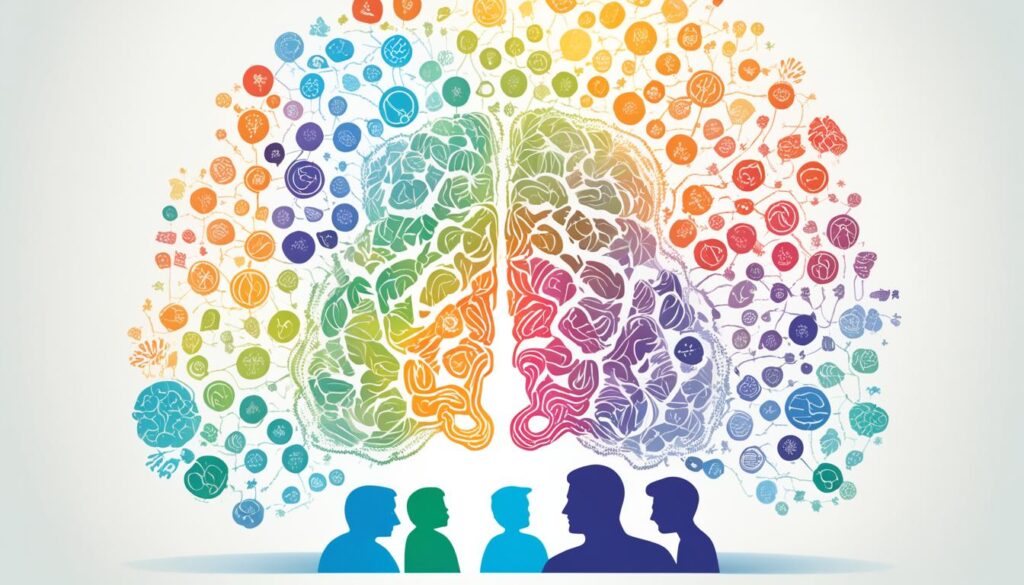
We’ve made big steps in understanding the needs of kids on the autism spectrum. Yet, we often forget how neurotypical kids can help make things better. By getting to know and accept autism, they can make a big difference. They can help build a caring and supportive community for everyone.
About one in 59 kids has autism. It’s key that we teach our young, neurotypical students about neurodiversity and how to support everyone. By really getting what autism is all about, we can raise kids who are not just okay with autism but also actively help their autistic friends.
Key Takeaways
- Autism affects one in 59 children, and one in six children has a developmental disability.
- Autism spectrum disorder presents a vast combination of possibilities, making each autistic child unique.
- Autistic individuals may have different learning styles and processing speeds that can be misinterpreted.
- Understanding and accepting autism is crucial for supporting the development of autistic children.
- Neurotypical children can play a vital role in creating an inclusive and empathetic environment for their autistic peers.
Understanding the Basics of Autism
Autism spectrum disorder (ASD) is a complex condition that changes how people see and interact with the world. People with autism see things differently, which brings both strengths and challenges. It’s key to see the diversity in autism and understand the different needs autistic kids have in school.
Explaining What Autism Is
Autism is a lifelong difference in the brain that affects how someone talks, senses, and thinks. Autistic people often have great skills in detail, solving problems, and being creative. But, they might struggle with recognizing faces, controlling their feelings, and handling social situations. This shows why each autistic person needs their own support and understanding.
Recognizing Different Needs and Accommodations
Autistic kids need special help with their senses because they might be too sensitive or avoid certain things like loud sounds or bright lights. Making the classroom more sensory-friendly, like using headphones or fidget toys, can make it better for them. They might also need clear instructions and pictures to help with talking and social skills. Plus, they might need more flexibility in how they learn and behave.
| Autism Characteristic | Potential Impact | Accommodations |
|---|---|---|
| Sensory processing differences | Sensitivity to noise, lights, textures, or physical touch | Sensory-friendly classroom, noise-canceling headphones, fidget toys |
| Communication challenges | Difficulty expressing thoughts and feelings, interpreting social cues | Visual aids, explicit instruction, alternative communication methods |
| Cognitive and behavioral differences | Restricted interests, inflexibility, difficulty with transitions | Structured routines, visual schedules, flexibility in expectations |

By getting to know the special needs of autistic kids and giving them the right help, we can make schools more welcoming and supportive. This lets them do their best and reach their goals.
Navigating Autism-Related Challenges
Understanding the unique challenges autistic individuals face is key for neurotypical kids to support their autistic friends. One big difference is handling emotions and behaviors, which can lead to meltdowns.
It’s key to know the difference between a tantrum and a meltdown. Tantrums are often for attention, while meltdowns come from too much sensory input or feeling overwhelmed. Neurotypical kids can learn to spot when a meltdown might happen. They can then offer emotional regulation and behavioral support to their autistic friends.
- Teach neurotypical kids to spot triggers for meltdowns, like loud sounds, bright lights, or changes in routine.
- Encourage them to suggest ways to calm down, like taking a break, using headphones, or doing something they like.
- Remind them that meltdowns aren’t chosen, but are how some people react to tough situations.
By learning about social skills and classroom management, neurotypical kids can be kind and supportive to their autistic friends. This makes the classroom a better place for everyone.
“The double empathy problem refers to the mutual misunderstanding that occurs between autistic and neurotypical individuals. Just as autistics struggle to understand neurotypicals, neurotypicals also struggle to understand autistics.”
Understanding and tackling the double empathy problem is vital in dealing with autism-related issues. By promoting acceptance, we can make a society where everyone can do well.
Neurotypical Kids Embrace Autism
Creating an Inclusive Environment
It’s important to make a place where neurotypical and autistic kids can meet and learn from each other. Inclusive playdates and sensory-friendly activities help make connections and understanding easier.
It’s key to teach neurotypical kids how to react to autistic behaviors and needs. Disability awareness and anti-bullying strategies stop misunderstandings and build empathy. Peer mentorship programs also help kids make positive friends and deal with social situations.
- Set up playdates that meet autistic kids’ sensory needs, making sure they feel safe and happy.
- Teach neurotypical kids about autism, showing off the special strengths and experiences of their autistic friends.
- Put in place anti-bullying rules and teach kids to be kind when they see or hear mean behavior.
- Push for peer-to-peer mentorship, letting neurotypical kids learn from and support their autistic classmates.
By making a welcoming space, we help neurotypical and autistic kids feel like they belong and respect each other. They can play, learn, and grow together.
Fostering Understanding and Acceptance
Learning about the neurodiversity movement and looking up to autistic role models helps us understand and accept autism better. By using autism-friendly books, media, and resources, parents and others can get more knowledge. This leads to a place where everyone feels welcome.
Learning from Autistic Individuals and Resources
Autistic people teach us the most about autism. Seeking out autistic voices and reading their stories gives us great insights. Also, community events and parent education help bridge the gap between us and autistic people. This builds empathy and acceptance.
- Explore autism-friendly books and media that show the real autistic life.
- Join community events that celebrate neurodiversity and teach about autism.
- Use educational resources and workshops to learn about understanding and supporting autistic individuals.
By joining the neurodiversity movement and learning from autistic role models, families can make a place that welcomes everyone. This lets neurotypical kids see the special talents and views of their autistic friends.
“Autism is a fundamental part of who I am, not a disorder to be cured. I’m proud of my autistic identity and the unique way I experience the world.”
– Sarah, Autistic Advocate
Conclusion
We’ve explored the world of autism and found its beauty in diversity and strength. Research shows us how autistic brains work differently, giving them special skills. These individuals show us the power of empathy and their unique talents.
This article highlights why we should accept and support those with autism. By doing so, we help them shine and use their talents in our world. We aim to make a place where everyone feels valued, no matter their brain’s wiring.
We must act to make a society that values neurodiversity. We can do this by pushing for inclusive policies, teaching others, or just being kind and understanding. Every action helps make a world where everyone feels safe and able to be themselves. Let’s work together to celebrate our differences and support each other’s strengths.
FAQ
What is autism?
Autism is a neurological disorder. It means autistic individuals have brains that process information differently. It’s a spectrum condition, so it affects people in many ways.
How can neurotypical children understand and respond to autism-related challenges?
It’s key to teach neurotypical kids to tell apart tantrums and meltdowns. They should learn how to support autistic friends during tough times. It’s also vital to understand what autistic kids need and how to help them.
What are some practical ways to create an inclusive environment for autistic and neurotypical children?
To make things inclusive, try having playdates that welcome everyone. Think about what autistic kids need in terms of senses. Teach neurotypical kids how to react to autistic behaviors and needs.
Learning and community involvement are also key. They help build understanding and acceptance.
How can neurotypical children and parents learn from autistic individuals and resources?
By joining the neurodiversity movement, finding autistic role models, and using autism-friendly books and media. This can broaden knowledge and views on autism.




